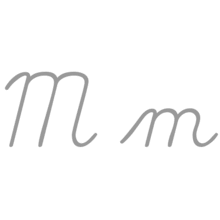M
| M | |
|---|---|
| M m | |
| (See below) | |
 | |
| Usage | |
| Writing system | Latin script |
| Type | Alphabet ic and Logographic |
| Language of origin | Latin language |
| Phonetic usage |
[m] [ɱ] [n] [n̼] /ɛm/ |
| Unicode value |
U+004D, U+006D |
| Alphabetical position |
13 Numerical value: 1000 |
| History | |
| Development | |
| Time period | ~-700 to present |
| Descendants |
• ₥ • ™ • ℠ • ᴟ • ꬺ • ꟽ ɯ ɰ • ꟿ • ᛗ |
| Sisters |
М Ӎ מ ם م ܡ מּ ﬦ Ⰿ ࠌ 𐌼 |
| Variations | (See below) |
| Other | |
| Other letters commonly used with | m(x) |
| Associated numbers | 1000 |
|
M (named em /ɛm/)[1] is the thirteenth letter of the modern English alphabet and the ISO basic Latin alphabet.
History
| Egyptian hieroglyph "n" | Phoenician Mem |
Etruscan M | Greek Mu |
Roman M | ||
|---|---|---|---|---|---|---|
The letter M is derived from the Phoenician Mem, via the Greek Mu (Μ, μ). Semitic Mem is most likely derived from a "Proto-Sinaitic" (Bronze Age) adoption of the "water" ideogram in Egyptian writing. The Egyptian sign had the acrophonic value /n/, from the Egyptian word for "water", nt; the adoption as the Semitic letter for /m/ was presumably also on acrophonic grounds, from the Semitic word for "water", *mā(y)-.[2]
Use in writing systems
The letter ⟨m⟩ represents the bilabial nasal consonant sound [m] in the orthography of Latin as well as in that of many modern languages, and also in the International Phonetic Alphabet. In English, the Oxford English Dictionary (first edition) says that ⟨m⟩ is sometimes a vowel in words like spasm and in the suffix -ism. In modern terminology, this is described as a syllabic consonant (IPA [m̩]).
Other uses
The Roman numeral Ⅿ represents the number 1000, though it was not used in Roman times. There is, however, scant evidence that the letter was later introduced in the early centuries by the Romans. [3]
Related characters
Descendants and related characters in the Latin alphabet
- M with diacritics: Ḿ ḿ Ṁ ṁ Ṃ ṃ M̃ m̃ ᵯ[4]
- IPA-specific symbols related to M: ɱ ɰ
- Ɱ : Capital M with hook
- Uralic Phonetic Alphabet-specific symbols related to M:[5]
- U+1D0D ᴍ LATIN LETTER SMALL CAPITAL M
- U+1D1F ᴟ LATIN SMALL LETTER SIDEWAYS TURNED M
- U+1D39 ᴹ MODIFIER LETTER CAPITAL M
- U+1D50 ᵐ MODIFIER LETTER SMALL M
- U+1D5A ᵚ MODIFIER LETTER SMALL TURNED M
- Some symbols related to M were used by the Uralic Phonetic Alphabet prior to its formal standardization in 1902:[6]
- U+2098 ₘ LATIN SUBSCRIPT SMALL LETTER M
- U+A7FA ꟺ LATIN LETTER SMALL CAPITAL TURNED M
- The Teuthonista phonetic transcription system uses U+AB3A ꬺ LATIN SMALL LETTER M WITH CROSSED-TAIL[7]
- Other variations used for phonetic transcription:[8] ᶆ ᶬ ᶭ
- Ɯ ɯ : Turned M
- ꟽ : Inverted M was used in ancient Roman texts to stand for mulier (woman)[9]
- ꟿ : Archaic M was used in ancient Roman texts to abbreviate the personal name 'Manius' (A regular capital M was used for the more common personal name 'Marcus')[9]
- ℳ : currency symbol for Mark
Ancestors and siblings in other alphabets
Ligatures and abbreviations
- ₥ : Mill (currency)
- ™ : Trademark symbol
- ℠ : Service mark symbol
Computing codes
| Character | M | m | ||
|---|---|---|---|---|
| Unicode name | LATIN CAPITAL LETTER M | LATIN SMALL LETTER M | ||
| Encodings | decimal | hex | decimal | hex |
| Unicode | 77 | U+004D | 109 | U+006D |
| UTF-8 | 77 | 4D | 109 | 6D |
| Numeric character reference | M | M | m | m |
| EBCDIC family | 212 | D4 | 148 | 94 |
| ASCII 1 | 77 | 4D | 109 | 6D |
- 1 Also for encodings based on ASCII, including the DOS, Windows, ISO-8859 and Macintosh families of encodings.
Other representations
References
- ↑ "M" Oxford English Dictionary, 2nd edition (1989); Merriam-Webster's Third New International Dictionary of the English Language, Unabridged (1993); "em," op. cit.
- ↑ See F. Simons, "Proto-Sinaitic — Progenitor of the Alphabet" Rosetta 9 (2011): Figure Two: "Representative selection of proto-Sinaitic characters with comparison to Egyptian hieroglyphs", (p. 38) Figure Three: "Chart of all early proto-Canaanite letters with comparison to proto-Sinaitic signs" (p. 39), Figure Four: "Representative selection of later proto-Canaanite letters with comparison to early proto-Canaanite and proto-Sinaitic signs" (p. 40). See also: Goldwasser (2010), following Albright (1966), "Schematic Table of Proto-Sinaitic Characters" (fig. 1).
- ↑ Gordon, Arthur E. (1983). Illustrated Introduction to Latin Epigraphy. University of California Press. p. 45. ISBN 9780520038981. Retrieved 3 October 2015.
- ↑ Constable, Peter (2003-09-30). "L2/03-174R2: Proposal to Encode Phonetic Symbols with Middle Tilde in the UCS" (PDF).
- ↑ Everson, Michael; et al. (2002-03-20). "L2/02-141: Uralic Phonetic Alphabet characters for the UCS" (PDF).
- ↑ Ruppel, Klaas; Aalto, Tero; Everson, Michael (2009-01-27). "L2/09-028: Proposal to encode additional characters for the Uralic Phonetic Alphabet" (PDF).
- ↑ Everson, Michael; Dicklberger, Alois; Pentzlin, Karl; Wandl-Vogt, Eveline (2011-06-02). "L2/11-202: Revised proposal to encode "Teuthonista" phonetic characters in the UCS" (PDF).
- ↑ Constable, Peter (2004-04-19). "L2/04-132 Proposal to add additional phonetic characters to the UCS" (PDF).
- 1 2 Perry, David J. (2006-08-01). "L2/06-269: Proposal to Add Additional Ancient Roman Characters to UCS" (PDF).



